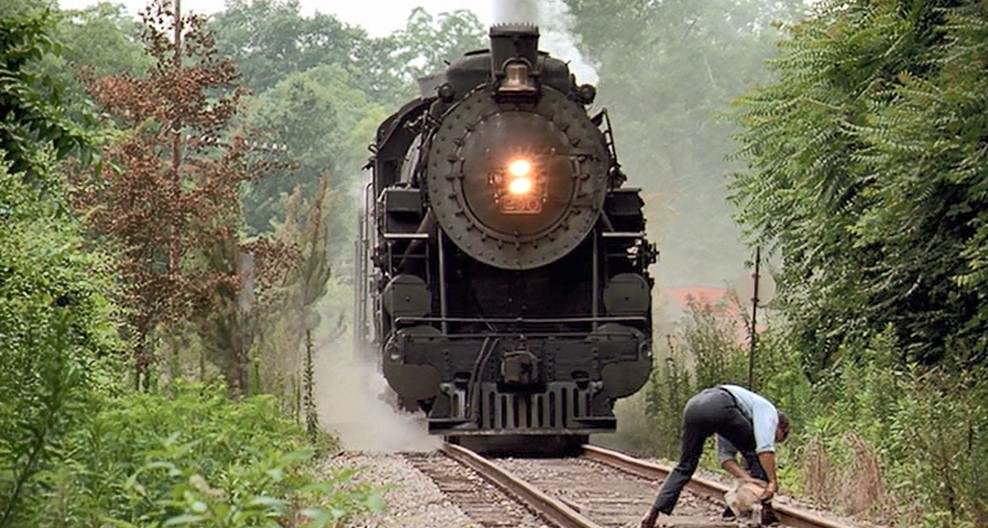
A World in Motion
Trains are often symbols of movement, change, and inevitable forward momentum. In Fried Green Tomatoes, the train is much more—it is destiny in motion, fate on tracks, and tragedy that cannot be undone. Its roaring presence is both literal and metaphorical: it slices through the story like a warning bell, reminding us that life does not wait. That innocence can be shattered in an instant.
The film’s most heart-wrenching moment—the death of Buddy Threadgoode—unfolds beside a train track, turning what had been a light-hearted, joyful sequence into a trauma that reshapes everything and everyone it touches.
Buddy’s Death: The End of Childhood
Young Idgie Threadgoode idolizes her brother Buddy. He is her protector, her playmate, her hero. Their connection is full of light: running through fields, teasing one another, dancing to phonograph music. Buddy is the heart of the family, and his charm extends beyond Idgie—he is beloved by all of Whistle Stop.
That’s why the suddenness of his death hits like a freight train.
As he walks with his sweetheart Ruth, teasing her hat off with boyish mischief, the moment feels carefree—then he races after the wind-tossed hat onto the tracks. A scream. A slip. The haunting sound of steel on steel. And it’s over.
The accident is not just a loss of life. It is the end of a world. The innocence of Whistle Stop is shattered. For Idgie, this moment breaks something permanent inside her.
The Aftermath: Idgie’s Descent and Withdrawal

In the wake of Buddy’s death, Idgie is changed. The vibrant, mischievous child withdraws into the woods, isolating herself from family, church, and community. She rejects everything that once brought comfort—especially the rigid expectations placed on her as a young girl.
This trauma doesn’t just scar her—it shapes her. It turns her from a tomboy into a rebel. From a preacher’s daughter into a lawless spirit who drinks, gambles, and runs with outcasts. The train did more than kill Buddy—it forged Idgie’s defiance.
The roar of the train becomes a ghost that follows her through life, and in many ways, Idgie never steps off the tracks of that fateful day. She simply finds new ways to keep moving forward.
The Train as Time and Fate
In literature and film, trains often represent the passage of time and the relentless march of fate. Fried Green Tomatoes uses this symbol masterfully. Buddy’s death was random, unplanned—but once it happens, there’s no turning back.
The train does not stop. It does not apologize. It simply keeps going.
This echoes throughout the film’s dual timeline structure. Evelyn, in the 1980s, is trying to reclaim a sense of self before it’s too late. Ninny, through her storytelling, is trying to slow time down—to preserve the beauty of Whistle Stop before it is forgotten. The train, in contrast, is indifferent. It is change incarnate.
And yet, even as it destroys, the train also connects. It brings Ruth to Whistle Stop. It brings travelers to the café. It keeps the small town from disappearing entirely. In that way, the train is not just destruction—it’s destiny.
The Tracks Between Past and Present
The rail tracks themselves—long, weathered, cutting through trees and memories—appear multiple times in the film. As a child, Idgie plays near them. As an adult, she walks alongside them with Ruth. As Ninny narrates, the tracks become metaphorical roads through time.
They are a pathway not just through geography but through memory.
When Evelyn imagines the past—or when we, the viewers, are drawn into it—the sound of a distant train seems to signal that shift. It reminds us we are stepping into another time, carried not by wheels but by stories.
The Last Train: Departure and Acceptance
Though Buddy’s death is the film’s first major tragedy, the final scenes are also steeped in the train’s symbolic meaning. As Evelyn learns to let go of the life that has constrained her and embraces her newfound strength, it feels like she, too, has stepped onto a new kind of train—one headed toward freedom, self-respect, and transformation.
The train that once took Buddy away now carries something else entirely: the power of change.
Ninny’s stories become the conductor, Evelyn the passenger, and the destination? A life no longer confined by fear.
The Emotional Echo
Every time the whistle sounds or tracks come into view, the emotional weight of Buddy’s death resurfaces. But it is no longer just a wound—it is also a reminder.
A reminder that love can endure tragedy. That grief can spark transformation. That the very moment that breaks you might also be the one that sets you on your true path.
Conclusion: Riding the Rails of Memory
In Fried Green Tomatoes, the train is not just a plot device. It is a force. It is what takes away, and also what brings forth. It ends childhood and begins the journey into adulthood. It is the sound of fate coming closer, the steel-spined reminder that life is both fleeting and precious.
More than anything, the train is memory—loud, unrelenting, unchangeable. But like the characters in the film, we don’t stand frozen on the tracks. We learn to step aside. To live with what has passed. And to walk beside those rails into whatever comes next.
